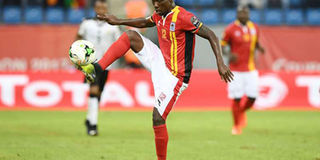Uganda is regional football king for East African reason

Uganda's defender Denis Iguma controls the ball during the 2017 Africa Cup of Nations Group D match between Ghana and Uganda in Port-Gentil on January 17, 2017. PHOTO | JUSTIN TALLIS | AFP
What you need to know:
- In Uganda, the towns along the main highway between the border with Kenya and the Democratic Republic of Congo are famous for their prostitutes.
- The children born to these women did not have deep tribal connections and were really urban kids.
- So when their peers with deep native roots went to farm or help their grandparents look after their cattle, they could not and had to pass their time in the townships, playing football in fields and taking to boxing.
And so, finally, the Africa Cup of Nations kicked off in Gabon.
This column was written early on Tuesday, as the Uganda national side, The Cranes, were set to face off with Ghana.
The Cranes qualified after a 38-year drought, so it really didn’t matter whether they won or lost.
The victory, ultimately, was already had by the team making it to the Afcon finals.
The Afcon finals raise two intriguing questions. First, though it currently doesn’t have a star like Kenya’s Victor Wanyama, who plays for English Premier League side Tottenham Hotspur, Uganda deserves bragging rights as the best East African national footballing side. That, despite the fact that it doesn’t treat its players that well. Rwanda does that much better than anyone else in the region.
My suspicion is that location, but most importantly sugarcane, and the Kenya-Uganda Railway explain Uganda’s football – and for a long while boxing – leadership in the region. Outside this regional context, you really can’t understand it. A lot of early sporting talent came from along the towns with major railway stations, trucker rest stops, and sugar plantations.
Being a relatively small country, for the truckers taking goods from the coast to eastern DR Congo, Rwanda, and Sudan (before the south broke off), the towns along the highway to the Central African hinterland are a transit corridor.
It explains why, in Uganda, the towns along the main highway between the border with Kenya and the DRC are more famous for their prostitutes than the ones in Kenya or Tanzania.
The children born to these women didn’t have deep tribal connections and were really urban kids. So when their peers with deep native roots went to farm or help their grandparents look after their cattle, they couldn’t. They had to pass their time in the townships, playing football in the fields and taking to boxing.
ASIAN COOLIES
It is not only truckers siring children along the highway. It actually started with the building of the Kenya-Uganda Railway, which brought to the country Asian coolies and workers from western Kenya.
When the railway was done, the Kenyan Luos, Samias and other Luhyas who had come as builders on the line, brought in their relatives to work in the sugar plantations.
Being largely working class, these towns also became bedrocks of the country’s trade union – and radical – movements in the 1960s and 1970s.
In the heyday of the railway and before the Idi Amin military dictatorship of the 1970s wrecked the economy and sugar plantations, in eastern Uganda towns like Lugazi and Kakira, there were perhaps more Kenyan than Ugandan workers living there. It is from these towns that the country’s footballing tradition, born partly out of cosmopolitanism, working class culture, and also a sense of alienation, comes.
In Kampala, decades ago, nearly 90 per cent of the country’s top athletes and footballers came from the Naguru working class neighbourhood. And it had the same characteristics, including a high proportion of Nubians.
I think football, because it requires 22 people to play, tracks very well and offers more opportunities in such working class places than running. You can train as a cross-country runner alone and be champion. You can’t get good at football playing alone. Football, for that reason, is a more enlightened sport. Running, I think, is more parochial.
ITS SLUMS
One of the main differences between Uganda and Kenya, then, is in its slums. For a long time, and indeed to this day, you cannot find a Ugandan slum that is dominated by a national ethnic group, or votes predictably. They are deeply cosmopolitan, in the sense that there is always a large group of people who are not “100 per cent Ugandan natives”.
A lot has changed, no doubt. But that history still runs in the blood of Ugandan football. And it is the last sport where those who are economically or politically marginalised, still find expression. You could say that the sport needs a degree of state failure, to keep feeding it.
Here is my wager then.
Two things would deal Ugandan football a deadly blow. One, if the country entered an era of extended prosperity and moved into sensible democratic politics beyond the current Yoweri Museveni imperial presidency-for-life.
Secondly, if a high-speed train track were to be built between Mombasa through Uganda to Rwanda and lead to the decline of the towns along the Northern Corridor.
Charles Onyango-Obbo is publisher, Africa data visualiser Africapedia.com and explainer site Roguechiefs.com.
Twitter: @cobbo3





